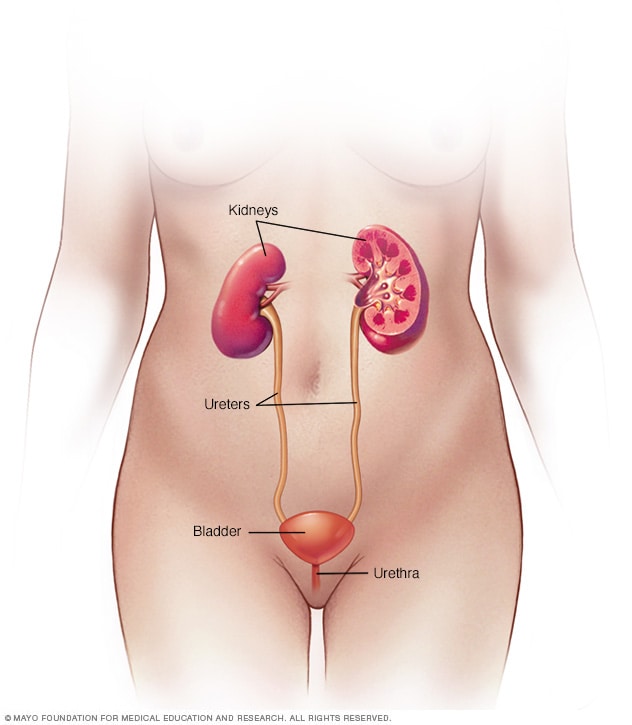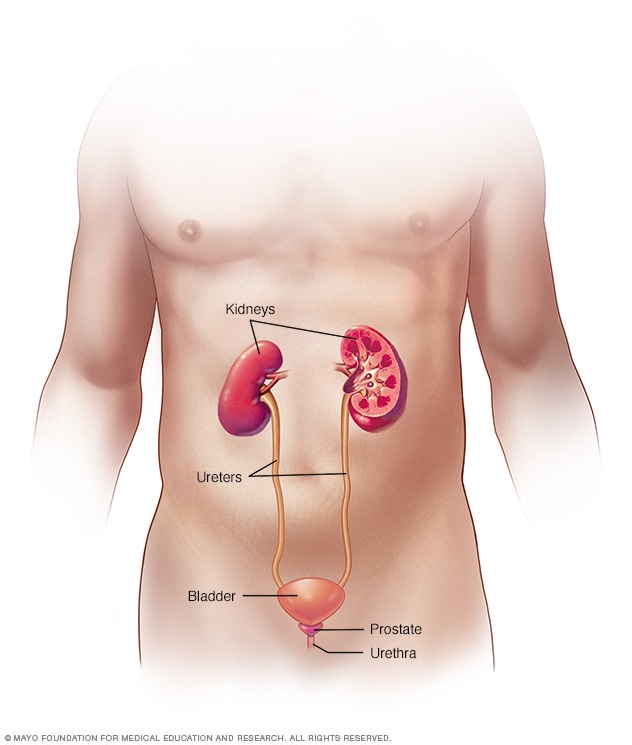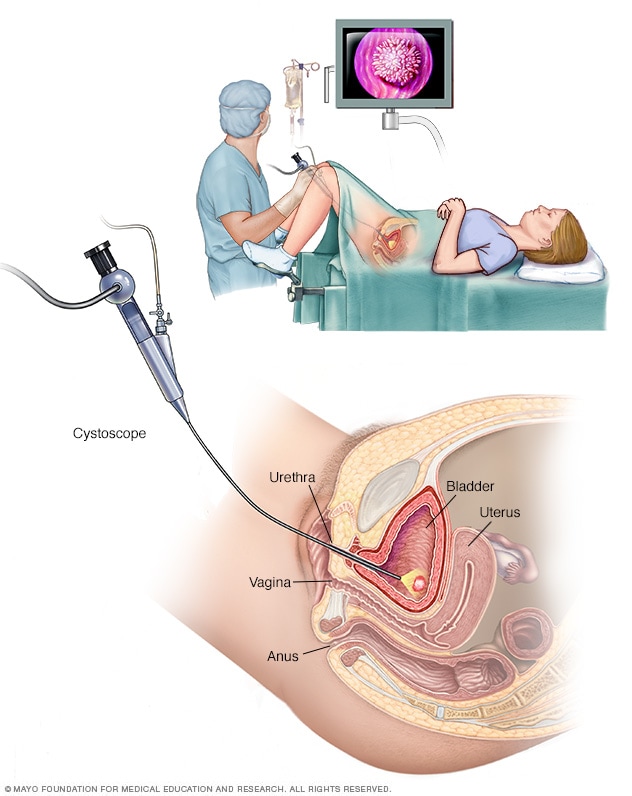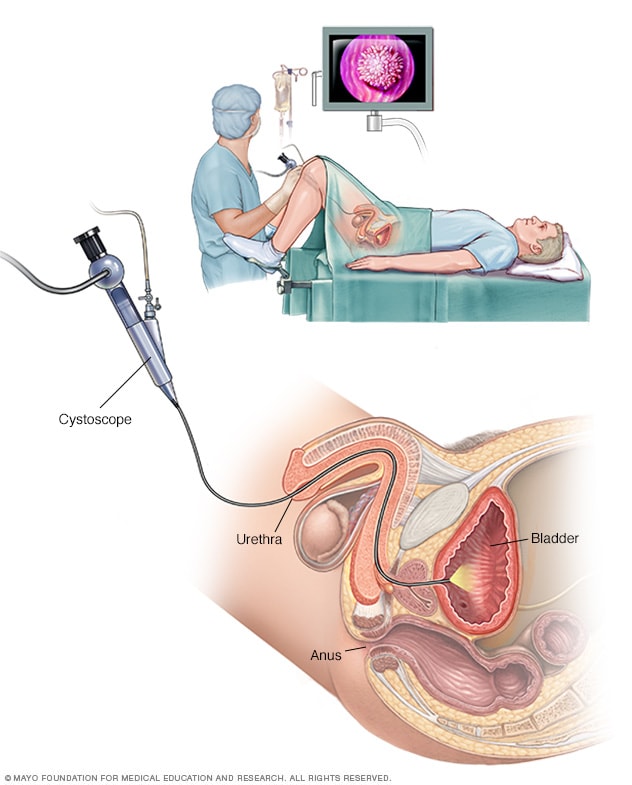Overview
Female urinary system

Female urinary system
The urinary system includes the kidneys, ureters, bladder and urethra. The urinary system removes waste from the body through urine. The kidneys sit toward the back of the upper abdomen. They filter waste and fluid from the blood and make urine. Urine moves from the kidneys to the bladder through narrow tubes called the ureters. The bladder stores urine until it's time to urinate. Urine leaves the body through a small tube called the urethra.
Male urinary system

Male urinary system
The urinary system includes the kidneys, ureters, bladder and urethra. The urinary system removes waste from the body through urine. The kidneys sit toward the back of the upper abdomen. They filter waste and fluid from the blood and make urine. Urine moves from the kidneys through narrow tubes to the bladder. These tubes are called the ureters. The bladder stores urine until it's time to urinate. Urine leaves the body through a small tube called the urethra.
Cystoscopy (sis-TOS-kuh-pee) is a procedure that lets a healthcare professional see the lining of the bladder and the tube that carries urine out of the body, called the urethra. A cystoscope is a flexible or rigid tube that has a lens. A healthcare professional puts the tube into the urethra and slowly moves it into the bladder.
You might have a cystoscopy in a medical exam room with a gel to numb your urethra. Or you might have medicine to relax you, called a sedative. Some cystoscopies happen in a hospital with medicine to put you in a sleeplike state called general anesthesia.
The type of cystoscopy you have depends on the reason for your procedure.
Products & Services
Why it's done
Cystoscopy can help diagnose, check and treat conditions that affect the bladder and urethra. For people assigned male at birth, cystoscopy also may check the prostate. Your healthcare professional might suggest cystoscopy to:
-
Look for the cause of symptoms. Symptoms may include blood in the urine; leaking of urine, called incontinence; sudden urges to urinate; and painful urination. Cystoscopy also can help find the cause of urinary tract infections that keep coming back.
You're not likely to have cystoscopy while you have a urinary tract infection.
- Diagnose bladder conditions. These may include bladder cancer and bladder stones.
- Treat bladder conditions. Healthcare professionals can pass special tools through the cystoscope to treat certain conditions. For instance, a healthcare professional may remove small bladder tumors during cystoscopy.
- Diagnose an enlarged prostate. Cystoscopy can show a narrowed urethra where it passes through the prostate gland. The narrowing may mean the prostate is larger than usual, called benign prostatic hyperplasia.
You might have a second procedure called ureteroscopy (u-ree-tur-OS-kuh-pee) at the same time as your cystoscopy. Ureteroscopy uses a smaller scope to look at the tubes that carry urine from the kidneys to the bladder, called the ureters.
More Information
Risks
Complications of cystoscopy can include:
- Infection. Rarely, cystoscopy can send germs into your urinary tract, causing an infection. Risk factors for getting a urinary tract infection after cystoscopy include older age, smoking and poor nutrition.
- Bleeding. Cystoscopy might cause some blood in your urine. Serious bleeding is rare.
- Pain. After the procedure, you might have lower belly pain and a burning feeling when you urinate. These symptoms most often are mild and get better over time.
Symptoms of a serious complication
Call your healthcare professional or go to the nearest emergency room if you:
- Can't urinate after cystoscopy.
- Have bright red blood or heavy blood clots in your urine.
- Have belly pain and upset stomach.
- Have chills.
- Have a temperature higher than 100.4 degrees Fahrenheit (38 degrees Celsius).
- Have pain or burning while urinating that lasts more than two days.
How you prepare
Before the procedure, your healthcare professional might ask you to:
- Take antibiotics. Your healthcare professional may prescribe antibiotics for you to take before and after cystoscopy. This is mainly true if you're at high risk of infection.
- Wait to empty your bladder. Your healthcare professional may order a urine test before your cystoscopy. Wait to empty your bladder until you get to your appointment in case you need to give a urine sample.
Arrange for someone to drive you home
You may have medicine through a vein into your arm to calm you or put you in a sleeplike state during cystoscopy. If so, have someone drive you home after the procedure.
What you can expect
During cystoscopy
Female cystoscopy

Female cystoscopy
Cystoscopy uses a thin, flexible tool with a light on the end, called a cystoscope. This allows a healthcare professional to see the inside of the urethra and bladder to diagnose conditions that affect the urinary tract.
Male cystoscopy

Male cystoscopy
Cystoscopy uses a thin, flexible tool with a light on the end, called a cystoscope. This allows a healthcare professional to see the inside of the urethra and bladder to diagnose conditions that affect the urinary tract.
A simple cystoscopy done in an exam room may take 5 to 15 minutes. When done in a hospital with medicine to calm you or put you in a sleeplike state, cystoscopy takes about 15 to 30 minutes.
Your cystoscopy procedure might involve these steps:
- You empty your bladder. Then you lie on a table on your back. Your feet may be in stirrups with your knees bent.
- You may get medicine to relax you or put you in a sleeplike state. A sedative may make you feel sleepy and relaxed during the cystoscopy, but you'll be aware. If you get a general anesthetic, you won't be aware during the procedure. You get either type of medicine through a vein in your arm.
- Your healthcare professional puts the cystoscope in place. You first get a cleaning agent on the skin at the opening of your urethra. A numbing gel put on your urethra helps prevent pain when the cystoscope goes in. After waiting a few minutes for the area to numb, your healthcare professional puts a small cystoscope into your urethra.
- Your healthcare professional may fill your bladder with sterile fluid. The fluid makes your bladder bigger to allow for a better look inside. As your bladder fills, you may feel the need to urinate. You can empty your bladder after the procedure.
- Your healthcare professional studies your urethra and bladder. The cystoscope has a lens on the end that makes the inner surfaces of your urethra and bladder look bigger. A special video camera over the lens may show the images on a screen.
- Your healthcare professional takes tissue samples, if needed. Your healthcare professional may use a larger cystoscope to take tissue samples for lab testing, or to do other procedures during the cystoscopy.
After the cystoscopy
You might be able to go about your day as usual. If you've had medicine to relax you or put you in a sleeplike state, you might stay in a recovery area for a time before you go home.
Side effects after cystoscopy might include:
- Bleeding from your urethra, which can look bright pink in your urine or on toilet tissue.
- A burning feeling while urinating.
- Urinating more often for the next day or two.
You can relieve some of the discomfort if you:
- Drink water to flush out your bladder. Try to drink 16 fluid ounces (473 milliliters) of water each hour for the first two hours after the procedure.
- Take a pain reliever you can get without a prescription.
- Put a warm, damp washcloth on the opening to your urethra to lessen pain. Repeat as needed.
- Take a warm bath, unless your healthcare professional tells you not to.
Call your healthcare professional if you have concerns after your cystoscopy.
Results
You might get the results of your cystoscopy right after your procedure.
Or you might need to make a follow-up appointment to get the results. If your cystoscopy involves getting a tissue sample to test for bladder cancer, your healthcare professional gives you the results when the results come back from the lab.
Clinical trials
Explore Mayo Clinic studies of tests and procedures to help prevent, detect, treat or manage conditions.
Oct. 25, 2025